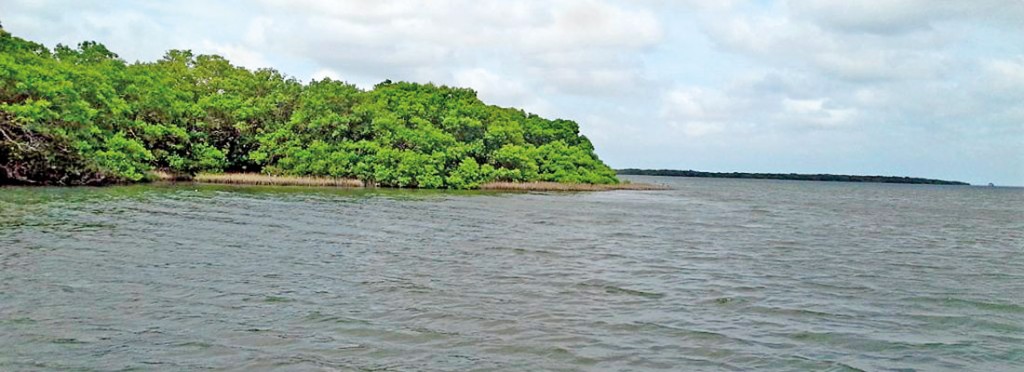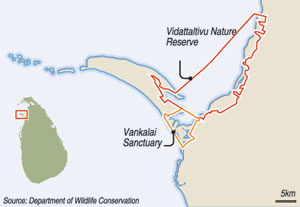News
Unique Vidattaltivu under threat

Mangroves on the Vidattaltivu coast, the only area in Sri Lanka where they face the sea. (Courtesy WNPS)
Serious concerns are being expressed by environmentalists over moves to revive a proposed large-scale aquaculture project, after de-gazetting a part of the protected Vidattaltivu Nature Reserve in the Mannar district.
Environmental lawyer Jagath Gunawardena said that the proposal had been strongly rejected by the Department of Wildlife Conservation (DWC) which had appointed a technical committee to study the impact of the aquaculture project on the sensitive and unique environment there.
While staunch conservationist Dr. Malik Fernando strongly called it a “bad precedent” which would pose a major threat to all Protected Areas (PAs), Mr. Gunawardena argued that “you cannot take a part of a PA without having a severe adverse impact on the whole eco-system prevalent there”.
This third largest Marine Protected Area, close to the Vankalai Sanctuary, was declared a Nature Reserve by Gazette 1956/13 on March 1, 2016 and covers 29,000 hectares. This followed the area being identified as needing protection by the Strategic Environmental Assessment (SEA) of the Northern Province conducted in 2012.
Incidentally, during the war, the Sea Tigers used the coastal town of Vidattaltivu as their base to control that coastal stretch.
The Fauna and Flora Protection Ordinance (FFPO) under which Vidattaltivu has been declared a Nature Reserve is very clear, says Mr. Gunawardena.
“Altering/ceasing of an already declared Nature Reserve can only be done subject to Section 2 (4) of the FFPO. The discretion exercisable by the Minister in this regard is limited by Section 2 (5) of the FFPO which sets out that ‘in the case of any change of boundaries or the disestablishment of a National Reserve, a study shall be conducted and such study shall include an investigation of the ecological consequences of the proposed change’,” quotes Mr. Gunawardena.
The crux of the matter is that the use of a PA for any purpose would cause destruction to it, he said, reiterating that around the world aquaculture has been found to be unsustainable.

Catch from the natural environment, which could vanish when the aquaculture project is implemented. (Courtesy WNPS)
Aquaculture is the controlled process of cultivating aquatic organisms for commercial purposes and Mr. Gunawardena underscores that investors are looking for gullible countries like Sri Lanka to carry out these harmful activities.
Citing Puttalam as an example, he says that after engaging in aquaculture in an area, you have to abandon those farms and move onto other areas.
“However much the National Aquaculture Development Authority (NAQDA) talks about eco-friendly technology, that becomes null and void if the site chosen is environmentally-sensitive and Vidattaltivu is. Why don’t they move north of Vidattaltivu where there is adequate land for such a project, without touching this area which is ecologically important? The reason they have picked Vidattaltivu is because for aquaculture to succeed, they need ecologically-strong areas with mangroves. They will use this area, cause massive destruction and then abandon it,” added Mr. Gunawardena.
The Environmental Foundation Ltd. (EFL) too reiterates that Vidattaltivu has a “rich and vibrant” ecosystem consisting of mangroves, tidal or mud flats, salt marshes, sea-grass beds and coral reefs which support the livelihoods of fishermen.
“It is a hub for the blue swimmer crab, a sought-after seafood, which brings foreign exchange to the country,” says the EFL.
 Strongly urging the stringent protection of Vidattaltivu which is “unique” in many ways, the Wildlife & Nature Protection Society (WNPS) points out that this is the only area in the whole of Sri Lanka where mangroves grow on the coast, facing the sea.
Strongly urging the stringent protection of Vidattaltivu which is “unique” in many ways, the Wildlife & Nature Protection Society (WNPS) points out that this is the only area in the whole of Sri Lanka where mangroves grow on the coast, facing the sea.
While mangroves in other areas are in lagoons and estuaries, in Vidattaltivu, the sea is like a lagoon and mangroves can take root in this sedimented coastal area. The coast is relatively protected from both the northeast and southwest monsoons.
Mangroves are vital in shielding the country from cyclones, storm surges and tsunamis (as experienced in 2004) and play a critical role in mitigating climate change, says the WNPS, adding that mangrove forests absorb up to four times more carbon per hectare than tropical forests, filter water, prevent erosion and contribute significantly to the livelihood of coastal communities as they are the breeding grounds for fish, shrimps and other aquatic species.
If this aquaculture project is implemented, there is also the danger of diseases getting into the natural system as experienced by Sri Lanka in the case of shrimp aquaculture in the Mundel-Puttalam areas, the WNPS says.

The extensive waterways within the mangroves ideal for kayaking and nature-based tourism. (Courtesy WNPS)
Some other concerns of the WNPS include the impact of such a project on migrant birds and the iconic, rare and endangered dugong (sea cow) which feeds on the sea-grass found here. While recognizing the need for investment and development of the fisheries industry, the WNPS suggests that other options such as high-value, nature-based tourism should be looked at without destroying unique Vidattaltivu.
“A myriad ecological and health impacts could follow the introduction of an alien species of prawn without an assessment of the effects of the species in Sri Lanka. These include the loss of mangroves which are the first line of defence against coastal erosion; loss of nurseries for fish and shellfish; and loss of biodiversity that comprise mangrove ecosystems and adjacent, ecologically connected littoral ecosystems,” adds EFL.
| Aquaculture park will have an eco-systems approach, says NAQDA DGWhy don’t the environmentalists who have concerns about the proposed industrial aquaculture park in Vidattaltivu have a discussion with me so that we can explain the measures taken to prevent an adverse impact on the area, said the Director-General (DG) of the National Aquaculture Development Authority (NAQDA), Nimal Chandraratne.The NAQDA has adopted the eco-systems’ approach in planning the project, he said, explaining that approvals from divisional level through to district level, including land-use committees and finally the Mannar District Development Committee, have been secured. “We are hearing concerns about the environment only through the media,” he said.Giving the sequence of events, Mr. Chandraratne said that in 2014, a land survey was carried out for the establishment of the aquaculture industrial park. The survey found that an area in Vidattaltivu, a state land, was suited for this. It was not a Protected Area then. The concept is for the government to build the infrastructure such as roads, common inlet and outlet canals, sedimentation tanks and water storage areas in the park and seek large and small investments for aquaculture. By 2015, they had the approvals and a design for the park. He said that the Department of Wildlife Conservation (DWC) also attended these meetings. However, by 2016, Vidattaltivu was declared a Nature Reserve. Referring to some of the concerns, Mr. Chandraratne who has visited the site 26 times said that the project would not lead to any destruction of mangroves, as the mangrove belt was far away near the sea. “We made sure that the park would be at least 300 metres from the mangroves. Provision has been made to protect even small clumps of mangroves located elsewhere.” He had also not seen many migratory birds in the area and requested environmentalists to do a proper survey to come up with data. When asked about flamingos, he said he had spotted some on the sand dunes but not in the area where the project would be. “Prawn farming which took off well in Puttalam and brought large amounts of foreign exchange had a setback in 2005 due to disease, but has picked up again. At that time there was no proper monitoring but everything is in place now. There were also fears of mangrove destruction but we re-planted those where necessary. We were accused of cutting mangroves which we grew again. Then there were allegations of Dutch canal issues but the canal was dredged. The whole industry is now regulated,” he said. With regard to diseases, the DG said that only specific-pathogen-free (SPF) parent stock which is internationally certified would be allowed to be imported, while a laboratory within the park would check for diseases. Monitoring would be carried out by the NAQDA along with the Department of Animal Production and Health. The hope is to increase prawn production to 100,000 metric tonnes by 2025. “We would use generators and water pumps with silencers to reduce noise. Waste would be sent to a big sedimentation tank and after all particles settle, the water recycled. No water would be sent out and as such sea-grass beds or corals will not be affected,” he said. | |

